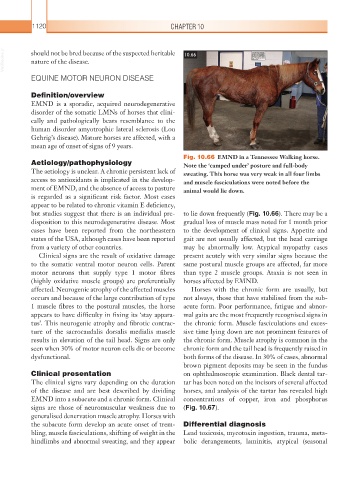Page 1145 - Equine Clinical Medicine, Surgery and Reproduction, 2nd Edition
P. 1145
1120 CHAPTER 10
VetBooks.ir should not be bred because of the suspected heritable 10.66
nature of the disease.
EQUINE MOTOR NEURON DISEASE
Definition/overview
EMND is a sporadic, acquired neurodegenerative
disorder of the somatic LMNs of horses that clini-
cally and pathologically bears resemblance to the
human disorder amyotrophic lateral sclerosis (Lou
Gehrig’s disease). Mature horses are affected, with a
mean age of onset of signs of 9 years.
Fig. 10.66 EMND in a Tennessee Walking horse.
Aetiology/pathophysiology Note the ‘camped under’ posture and full-body
The aetiology is unclear. A chronic persistent lack of sweating. This horse was very weak in all four limbs
access to antioxidants is implicated in the develop- and muscle fasciculations were noted before the
ment of EMND, and the absence of access to pasture animal would lie down.
is regarded as a significant risk factor. Most cases
appear to be related to chronic vitamin E deficiency,
but studies suggest that there is an individual pre- to lie down frequently (Fig. 10.66). There may be a
disposition to this neurodegenerative disease. Most gradual loss of muscle mass noted for 1 month prior
cases have been reported from the northeastern to the development of clinical signs. Appetite and
states of the USA, although cases have been reported gait are not usually affected, but the head carriage
from a variety of other countries. may be abnormally low. Atypical myopathy cases
Clinical signs are the result of oxidative damage present acutely with very similar signs because the
to the somatic ventral motor neuron cells. Parent same postural muscle groups are affected, far more
motor neurons that supply type 1 motor fibres than type 2 muscle groups. Ataxia is not seen in
(highly oxidative muscle groups) are preferentially horses affected by EMND.
affected. Neurogenic atrophy of the affected muscles Horses with the chronic form are usually, but
occurs and because of the large contribution of type not always, those that have stabilised from the sub-
1 muscle fibres to the postural muscles, the horse acute form. Poor performance, fatigue and abnor-
appears to have difficulty in fixing its ‘stay appara- mal gaits are the most frequently recognised signs in
tus’. This neurogenic atrophy and fibrotic contrac- the chronic form. Muscle fasciculations and exces-
ture of the sacrocaudalis dorsalis medialis muscle sive time lying down are not prominent features of
results in elevation of the tail head. Signs are only the chronic form. Muscle atrophy is common in the
seen when 30% of motor neuron cells die or become chronic form and the tail head is frequently raised in
dysfunctional. both forms of the disease. In 30% of cases, abnormal
brown pigment deposits may be seen in the fundus
Clinical presentation on ophthalmoscopic examination. Black dental tar-
The clinical signs vary depending on the duration tar has been noted on the incisors of several affected
of the disease and are best described by dividing horses, and analysis of the tartar has revealed high
EMND into a subacute and a chronic form. Clinical concentrations of copper, iron and phosphorus
signs are those of neuromuscular weakness due to (Fig. 10.67).
generalised denervation muscle atrophy. Horses with
the subacute form develop an acute onset of trem- Differential diagnosis
bling, muscle fasciculations, shifting of weight in the Lead toxicosis, mycotoxin ingestion, trauma, meta-
hindlimbs and abnormal sweating, and they appear bolic derangements, laminitis, atypical (seasonal

